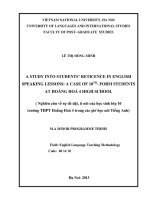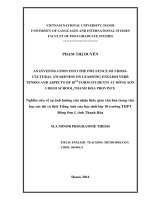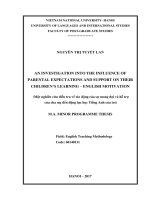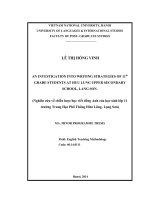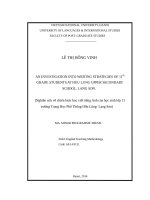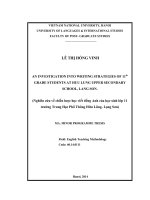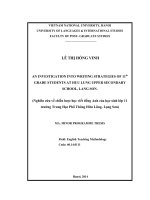An investigation into the influence of cross-cultural awareness on learning English verb tenses and aspects of 10th form students at Đong Son I high school, Tha
Bạn đang xem bản rút gọn của tài liệu. Xem và tải ngay bản đầy đủ của tài liệu tại đây (502.86 KB, 65 trang )
VIETNAM NATIONAL UNIVERSITY, HANOI
UNIVERSITY OF LANGUAGES AND INTERNATIONAL STUDIES
FACULTY OF POST-GRADUATE STUDIES
*********************
PHẠM THỊ DUYÊN
AN INVESTIGATION INTO THE INFLUENCE OF CROSSCULTURAL AWARENESS ON LEARNING ENGLISH VERB
TENSES AND ASPECTS OF 10TH FORM STUDENTS AT ĐƠNG SƠN
I HIGH SCHOOL,THANH HĨA PROVINCE
Nghiên cứu về sự ảnh hưởng của nhận thức giao văn hóa trong việc
học các thì và thời Tiếng Anh của học sinh lớp 10 trường THPT
Đơng Sơn I, tỉnh Thanh Hóa
M.A MINOR PROGRAMME THESIS
FIELD: ENGLISH TEACHING METHODOLOGY
CODE: 60140111
Hanoi, 2014
VIETNAM NATIONAL UNIVERSITY, HANOI
UNIVERSITY OF LANGUAGES AND INTERNATIONAL STUDIES
FACULTY OF POST-GRADUATE STUDIES
*********************
PHẠM THỊ DUYÊN
AN INVESTIGATION INTO THE INFLUENCE OF CROSSCULTURAL AWARENESS ON LEARNING ENGLISH VERB
TENSES AND ASPECTS OF 10TH FORM STUDENTS AT ĐƠNG SƠN
I HIGH SCHOOL,THANH HĨA PROVINCE
Nghiên cứu về sự ảnh hưởng của nhận thức giao văn hóa trong việc
học các thì và thời Tiếng Anh của học sinh lớp 10 trường THPT
Đơng Sơn I, tỉnh Thanh Hóa
M.A MINOR PROGRAMME THESIS
FIELD: ENGLISH TEACHING METHODOLOGY
CODE: 60140111
SUPERVISOR: NGUYỄN THỊ MINH TÂM, PhD.
Hanoi, 2014
DECLARATION
I hereby certify that the thesis entitled
“AN INVESTIGATION INTO THE INFLUENCE OF CROSS-CULTURAL
AWARENESS ON LEARNING ENGLISH VERB TENSES AND ASPECTS OF
10TH FORM STUDENTS AT DONG SON I HIGH SCHOOL – THANHHOA
PROVINCE”
is the result of my own research for the Degree of Master of Arts at University of
Languages and International Studies, Vietnam National University – HaNoi and that
this thesis has not been submitted for any degree at any other university or tertiary
institution.
Signature
Phạm Thị Duyên
i
ACKNOWLEDGEMENTS
First I would like to express my sincere and deep gratitude to my supervisor,
Dr. Nguyễn Thị Minh Tâm, who has given me great help with this thesis. Without
her experienced guidance, valuable suggestions and dutiful supervision, my
research would be far from completed.
I would also like to acknowledge my debt of gratitude to Assoc.Prof.Dr. Lê
Hùng Tiến and the staff members at Faculty of Graduate and Post Graduate Studies,
University of Languages and International Studies, Vietnam National University –
HaNoi for their valuable lectures, which laid the foundation of this thesis and for
their knowledge as well as their sympathy.
I am also grateful to the librarians at the Resource Centre, who are willing to
lend me a lot of interesting books and valuable materials for my thesis.
I take this opportunity to thank all students and teachers at Dong Son I High
school for their help and co-operation during the time I collected the data.
Last but not least, I would like to express my thanks to my beloved family
who continually gave me a lot of support and encouragement for the fulfillment of
this challenging work.
ii
ABSTRACT
The interrelationship between language and culture results in the fact that
cultural knowledge plays a very important role in the process of learning English
verb tenses and aspects. Therefore, the awareness of an important cross-cultural
category Accuracy – Inaccuracy will help students use English more appropriately.
The thesis focuses on the influence of this category on learning English verb tenses
and aspects of 90 10th form students at Đông Sơn I High School through a test and
informal interviews with 6 students and with 2 teachers to find out the problems
students have in learning English verb tenses and aspects. Based on the findings,
some suggestions for the teaching of English as a foreign language will be given
with the hope that they will contribute to improve students’ learning verb tenses and
aspects.
iii
ABBREVIATIONS
L1: MOTHER TONGUE
L2: SECOND LANGUAGE
SLA: SECOND LANGUAGE ACQUISITION
CCA: CROSS-CULTURAL AWARENESS
DSHS: ĐÔNG SƠN I HIGH SCHOOL
iv
LIST OF CHARTS AND TABLES
CHARTS:
Chart 1: Students’ responses to the test with the tenses
Chart 2: Students’ responses to the test with the aspects
Chart 3: Students’ responses to the test with the tenses and aspects
Tables:
Table 1: Twelve verb tense-aspect combinations
Table 2: The number of infinitive verbs for conjugation of the test
v
TABLE OF CONTENTS
DECLARATION ........................................................................................................ i
ACKNOWLEDGEMENTS ......................................................................................ii
ABSTRACT ............................................................................................................. iii
ABBREVIATIONS .................................................................................................. iv
LIST OF CHARTS AND TABLES ......................................................................... v
TABLE OF CONTENTS ......................................................................................... vi
PART A: INTRODUCTION .................................................................................... 1
1. Rationale for the study ............................................................................................ 1
2. Aims of the study .................................................................................................... 2
3. Research questions .................................................................................................. 2
4. Scope of the study ................................................................................................... 2
5. Significance of the study ......................................................................................... 2
6. Methods of the study ............................................................................................... 3
7. Organization of the study ........................................................................................ 3
PART B: DEVELOPMENT..................................................................................... 4
CHAPTER 1: LITERATURE REVIEW ................................................................ 4
1.1. Cross-cultural awareness in second language acquisition (SLA ......................... 4
1.1.1. SLA and factors influencing students’ SLA processes .................................... 4
1.1.2. Cross-cultural awareness and its influence on language learning .................... 6
1.2. Tenses and aspects ............................................................................................... 7
1.2.1. Tenses and aspects of English ........................................................................... 8
1.2.2. Tenses and aspects of Vietnamese .................................................................... 9
1.3. The influence of cross-cultural awareness in the process of learning verb tenses
and aspects................................................................................................................. 11
1.4. Review of previous study ................................................................................... 16
CHAPTER 2: METHODOLOGY ......................................................................... 18
2.1. The context of teaching and learning English at Đông Sơn I
High School .............................................................................................................. 18
vi
2.2. Research questions restated ............................................................................... 19
2.3. Research instruments, data collecting procedure and
summary of findings ................................................................................................. 20
2.3.1. Test .................................................................................................................. 20
2.3.2. Interview with students ................................................................................... 24
2.3.3. Interview with teachers ................................................................................... 26
CHAPTER 3: FINDINGS AND DISCUSSION ................................................... 28
3.1. Research question 1............................................................................................ 28
3.1.1. Problem caused by un-equivalence in the conception
of tenses and aspects in English and Vietnamese ..................................................... 28
3.1.2. Problem caused by understanding about the meaning and use of
markers in the expression of tenses and aspects in English and Vietnamese ........... 30
3.1.3. Problem caused by inadequate exploitation of co-text clues to interpret
the tenses and aspects in English and in Vietnamese................................................ 31
3.1.4. Problem caused by inappropriate choice of mode to manifest tenses
and aspects in English and in Vietnamese ................................................................ 33
3.2. Research question 2............................................................................................ 34
3.2.1. To the teachers ................................................................................................ 34
3.2.2. To the board of management .......................................................................... 37
PART C: CONCLUSION....................................................................................... 38
1. Recapitulation ....................................................................................................... 38
2. Implications of the study ....................................................................................... 38
3. Limitations of the study ........................................................................................ 39
4. Suggestions for further study ................................................................................ 39
REFERENCES ........................................................................................................ 40
APPENDICES ........................................................................................................... I
vii
PART A: INTRODUCTION
1. Rationale for the study
It cannot be denied that learning English is now a must for youngsters in
Vietnam, especially when Vietnam has joined the World Trade Organization
(WTO). English has become a compulsory subject at high schools throughout the
country. For too long, we have been concentrating on structures and forms and
producing materials that may help our students to have perfect diphthongs or a
flawless command of the third conditional while leaving out anything approaching
real, valid, meaningful content. If our students are to have any hope of using their
language skills to genuinely comprehend and communicate in the global village,
cross-cultural awareness is crucial.
It can be said that Vietnamese culture still has certain influences on
Vietnamese learners’ acquisition of English. The interference of the native culture,
to some extents, may limit students’ ability to acquire the second language
comprehensively. Moreover, the researcher’s observation also points out that
students get many difficulties in recognizing errors caused by the interference of
their own Vietnamese cultural thought patterns. One of the most common mistakes
made by Vietnamese students is in using English verb tenses and aspects. The
mistake in conjugating verbs is inevitable whenever using or practicing English for
any skills. Many students claim that they always have problems with this part
because using verbs in English is very different from that in Vietnamese. It is crosscultural difference in using language that is the cause of students’ mistakes. Much
of the reason lies in the fact that students do not pay attention to the difference in
using verb tenses and aspects in Vietnamese and in English. Additionally, it is a
tradition that in Vietnam, English teaching process focuses on only linguistic
competence and cultural knowledge is not concentrated on.
This situation has inspired me to do research on cross-cultural awareness in
the process of learning English verb tenses and aspects with the focus on the crosscultural category proposed in Nguyễn Quang’s work (2002), namely Accuracy –
1
Inaccuracy. This study is, hence, aimed at investigating the influence of crosscultural awareness on learning English verb tenses and aspects for 10th form
students at Dong Son I High School, and providing some recommendations.
2. Aims of the study
The study aims to find out to what extent cross-cultural awareness
influences the process of learning English verb tenses and aspects of 10th form
students at Đông Sơn I High School. Then some suggestions will be given to help
students improve their learning English verb tenses and aspects.
3. Research questions
This research is carried out to find out the answers to the following research
questions:
- To what extent does cross-cultural awareness influence the process of learning
English verb tenses and aspects of 10th form students at Đông Sơn I High School –
Thanh Hóa province?
- What are the suggestions for improving students’ learning of English verb tenses
and aspects?
4. Scope of the study
The study focuses on investigating the influence of cross-cultural awareness
on the process of learning English verb tenses and aspects of 10th form students.
Due to the limitation of time and knowledge, there will be one cross-cultural
category proposed in Nguyễn Quang’s work (2002), namely Accuracy - Inaccuracy
presented in the literature review, and the concepts related to this category will be
explored in the process of data analysis.
5. Significance of the study
The investigation provides an insightful awareness of the influences of
Vietnam’s culture on learning English verb tenses and aspects. As for students,
identifying what interferes on learning English verb tenses and aspects will help
them overcome their mistakes in order to improve their English. As for teachers,
this is a good chance for them to reconsider the role of culture in learning English.
2
Suggestions proposed in this research could provide teachers with ideas on how to
improve students’ learning of English tenses and aspects. Besides, the study is also
hoped to lay the foundation for further research into the issue within a larger scope.
6. Methods of the study
To realize the aims of the study, the researcher uses a case study. The case is
the students of 10th form and the teachers of English at Đông Sơn I High School in
Thanh Hóa Province. Data will be collected through the analysis of the test and
interviews. A test is implemented with 90 10th form students who are chosen
randomly. The informal interviews with 6 out of 90 students are conducted basing
on their answers to the test. They are asked to explain their answers to the test. The
other informal interviews with 2 experienced teachers are to find out the way for
teachers to help student overcome their mistakes in learning English verb tenses
and aspects and improve their English.
7. Organization of the study
The study is divided into three main parts.
Part A – Introduction. In this part, the rationale, the aims, the research questions,
the scope, the significance, the method, and the design of the study are presented.
Part B – Development. This part is composed of three chapters. Chapter 1:
Literature Review. This chapter reviews the related literature that helps to give the
theoretical foundation for the study. This review consists of the literature on crosscultural awareness in second language acquisition, tenses and aspects, and the
influence of cross-cultural awareness in the process of learning verb tenses and
aspects. Chapter 2: Methodology. This chapter describes the context of the study,
the research instruments, the data collection, the data analysis and the findings.
Chapter 3: Findings and Discussions . This chapter presents the discussion and
some teaching and learning implications.
Part C – Conclusion. This part summarizes the study, states the concluding
remarks, the limitation of the research and offers suggestions for the further research.
3
PART B: DEVELOPMENT
CHAPTER 1: LITERATURE REVIEW
This chapter provides a brief review of the theoretical knowledge relevant to
the study including Cross-Cultural Awareness in second language acquisition;
Tenses and aspects in English and in Vietnamese; The influence of cross cultural
awareness in the process of learning verb tenses and aspects which will be taken
into consideration as key concepts.
1.1. Cross-Cultural Awareness in second language acquisition (SLA)
1.1.1. SLA and factors influencing students’ SLA processes
According to Gass (1994), “SLA refers to the process of learning another
language after the native language has been learned. Sometimes, the term even
refers to the learning of a third or fourth language”(Gass, 1994:5). He points out
“The important aspect is that SLA refers to the learning of a nonnative language
after the learning of one’s native or primary language”(Gass, 1994:5).
According to Sawill (2006), “SLA refers both to the study of individuals and
groups who are learning a language subsequent to learning their first one as young
children, and to the process of learning that language. The additional language is
called a second language, even though it may actually be the third, fourth, or tenth
to be acquire. It is also commonly called a target language, which refers to any
language that is the aim or goal of learning” (Sawill, 2006: 7)
The above definitions share a common point that SLA is the process of
learning another language apart from the native language. The process, thus, is
influenced by what factors. There are many factors that have an effect on SLA
processes such as age, sex, attitudes, motivation, language learning goals, aptitude,
degree of awareness, native language, etc. Four prominent factors motivation,
attitude, anxiety, and the influence of L1 on L2 acquisition are elaborated as
follows
- Motivation
Most researchers and educators would agree that motivation is a very
4
important, if not the most important factor in language learning, without which
even “gifted” individuals cannot accomplish long-term goals. Gardner (1985)
defines motivation to learn an L2 as “the extent to which the individual works or
strives to learn the language because of a desire to do so and the satisfaction
experienced in this activity”(Gardner, 1985:47). So the motivation of SLA refers to
the desire and impetus of the acquirers. Sheorin (1996) also point out “Motivation
is important because it directly influences how often students use second language
learning strategies, how much students interact with native speakers, how much
input they receive in the language being learned, how well they do on curriculumrelated achievement tests, how high their general proficiency level becomes, and
how long they preserve and maintain second language skills after language study is
over”(Sheorin, 1996:121).
- Attitude
Collins Cobuild Student’s Dictionary explains that: “Your attitude to
something is the way you think and feel about it”. Psychological theories on
attitudes refers to an evaluative, emotional reaction (i.e. the degree of like or dislike
associated with the attitudinal object) comprising three components: affect,
cognition, and behavior. How attitude influences the SLA are shown as follows:
+ The acquirers with positive attitude tend to learn L2 easily and with rapid
progress; while those with negative attitude make slowly progress.
+ Attitude decides the commitment. Those who give up halfway are probably
passive with lower commitment whose achievements are lower than positive and
persistent learners.
+ Attitude influences the class participation. The students with positive
learning attitude perform actively and can have high grade.
- Anxiety
From the SLA perspective, Gardner (1985) sees language anxiety as “the
apprehension experienced when a situation requires the use of a second language
with which the individual is not fully proficient”, this apprehension being
5
characterized by “derogatory self-related cognitions, feelings of apprehension, and
physiological responses such as increased heart rate”(Gardner, 1985:19). There are
correlations between anxiety and performance.
- The influence of L1 on L2 acquisition
Second or foreign language learner uses first language knowledge and
various strategies to facilitate their learning of target language (i.e., speaking,
reading, and writing). This phenomenon is known as language transfer. Transfer
occurs consciously as a deliberate communication strategy, where there is a gap in
the learner’s knowledge; and unconsciously either because the correct form is not
known or because, although it has been learned, it has not been completely
automatized (Benson, 2002). According to Chomsky’s universal grammar theory
(1979), humans produce language through a deep structure that enables them to
generate and transfer their own grammar to any other language. As people learn
languages, they develop certain skills. They naturally transfer the skills learned in
the first language (L1) to the second language (L2). O’Malley and Chamot (1990)
define transfer as “the use of previous linguistic or prior skills to assist
comprehension or produce”(O’Malley and Chamot, 1990:57). This indicates that
while learning second language, learners transfer their first language knowledge or
skills. This transfer process may either support (positive transfer) or detract
(negative transfer) from learning. Transfer can be facilitative, in areas where the
two languages are identical.
The above factors will help researcher partly get the aim of the study: find out
the problems the 10th form students at Dong Son I High School have in learning
English verb tenses and aspects.
1.1.2. Cross Cultural Awareness and its influence on language learning
Cross Cultural Awareness (CCA) or Intercultural Awareness in language
learning is talked about as though it were a fifth skill (Damen, 1986). Intercultural
learning is the process of becoming more aware of and better understanding one’s
own culture and other cultures around the world.
6
For such a long time, learning target language cultures is so important that it
has been stressed by a number of writers. Kramsch (1993) points out: “If language
is seen as social practice, culture becomes the very core of language teaching.
Cultural
awareness
must
then
be
viewed
as
enabling
language
proficiency”(Kramsch, 1993:98). She further explains : “Language is inextricable
connection to culture. We cannot be competent in the language if we do not also
understand the culture that has shaped and informed it. We cannot learn a second
language if we do not have an awareness of that culture, and how that culture
relates to our first language / first culture. It is not only therefore essential to have
cultural awareness, but also cross cultural awareness”(Kramsch, 1993: 98)
In learning language, language knowledge cannot be separated from culture as
Edward Sapir (1921, cited in Valdes, 1986) stated that “language does not exist
apart from culture, which is from the socially inherited assemblage of practices and
beliefs that determines the texture of our lives”(cited in Valdes, 1986:123). Without
the study of culture, foreign language instruction is inaccurate and incomplete. For
foreign language students, language study seems senseless if they know nothing
about the people who speak it or the country in which it is spoken.
Cultural differences therefore affect language users’ choice of language and
acquisition of linguistic concepts. English native speakers and English learners, for
example, may have different ways of using one or the same word (the word dog
may be used with positive connotation by English native speaker but with negative
connotation by Vietnamese learners of English). Another example is: Vietnamese
learners of English may, in many cases, find English tense-aspect combinations that
do not have equivalents in Vietnamese unlearnable.
1.2. Tenses and aspects
Tense and aspect are the concepts used to express time, which is a universal
notion. Several linguists and grammarians have attempted to define tense. Hockett
(1958) states “tense typically shows different locations on an event in
7
time”(Hockett, 1958:237). Lyons (1977) presented a broader definition of tense by
saying:
The essential characteristic of the category of tense is that it relates the time
and the action, event or state of affairs referred to in the sentence to the time
of the utterance being “now”. (Lyons, 1977:305)
Comrie (1976) indicates “tense relates the time of the situation referred to, to
some other time, usually to the moment of speaking”(Comrie, 1976:1). He believes
that “aspects are different ways of viewing the internal temporal constituency of a
situation”(Comrie, 1976:2).
Time which is distinct from tense merely refers to the actual physical time in
the real world. According to Quirk and Greenbaum (1973), the units of time are
extra-linguistic which is independent on the grammar of any particular language.
The relation between time and tense is language specific. For instance,
English time and verb tense are associated by means of verbal inflections and
auxiliaries, and it is stated by Quirk and Greenbaum (1973) that there exists only
tenses in English: past tense and present tense. In Vietnamese, however, time is not
expressed through verb tense. The use of tense in relation to time reference is
relatively subjective and context-dependent. Vietnamese speakers refer to time not
by using verbal inflections, but by using temporal expression or other makers,
which are highly specific to particular contexts of use.
Aspect has been defined by many traditionalists and modern linguists. Hockett
(1958) indicates that “aspects have to do not with the location of an event in time,
but with its temporal distribution or contour”(Hockett, 1958:493). Quirk and
Greenbaum (1973) state that aspect concerns the manner in which the verbal action
is experienced or regarded (completed or in progress).
1.2.1. Tenses and aspects of English
The English verb phrase comprises finite and non-finite verb phrases. In finite
verb phrases, both tense and aspect are construed through the conjugation of the
verbs. Verb tense indicates the time in which an action occurs, either present or
8
past. Future time is not expressed through verb inflections but through the use of
auxiliaries will, would, shall or through structures like be going to, be about to, etc.
(Quirk and Greenbaum, 1973). For example, the present tense of the verb to give is
give or gives, the past tense is gave, and the future tense is will give. On the other
hands, aspect shows whether an action happens habitually, continuously, or
repeatedly (Quirk and Greenbaum, 1973). English has four aspects: simple (or zero
aspect), progressive, perfective, and perfective progressive (Murcia & Freeman,
1998). These four aspects are illustrated in the following examples:
She speaks English with her boyfriend every day. (simple)
She is speaking English with her boyfriend at the moment. (progressive)
She has spoken English with her boyfriend very often recently. (perfect)
She has been speaking English with her boyfriend for nearly two hours.
(perfect progressive)
Although there is a difference between tense and aspect, according Murcia
and Freeman (1998), it is obvious that tense and aspect are intermingled in any
finite verb phrases. The combination of tense and aspect in English verb phrases,
hereby called tense-aspect combinations in this thesis, can be categorized into
twelve types/ combinations: present simple, present progressive, present perfect,
present perfect progressive, past simple, past progressive, past perfect, past perfect
progressive, future simple, future progressive, future perfect, and future perfect
progressive.
1.2.2. Tenses and aspects of Vietnamese
Vietnamese has its own way to construe the notion of time through tense and
aspect. Đoàn Hải (2007) pointed out that “In Vietnamese, verbs are not conjugated,
and tense and aspect are generally understood in the context”(Đoàn Hải, 2007:25).
Similarly, Đàm Trung Pháp (2001) also stated that tense and aspect are usually
implied and understood in context, even though Vietnamese has particles to mark
them when needed. For example, the Vietnamese sentence Chị ấy ngủ [sister-theresleep] can be translated into English as She is sleeping, She slept, She sleeps, or She
9
has slept, depending on the context. When adverbial elements such as trước đây
[ago, before] or bây giờ [now, at the moment] are used in the sentence, tense –
and/or aspect- making particles are generally omitted.
In another description of tense and aspect in Vietnamese, Cao Xuân Hạo, an
influential Vietnamese linguist, argued that Vietnamese does not have tense; it only
has aspect. According to Cao Xuân Hạo (1998), Vietnamese uses đã to mark the
perfect aspect, đang to mark the progressive aspect, and sẽ to mark an uncertain
state expressed by verbs expressing hopes, wishes, guesses, and conditions. For
example:
(1) Họ
They
đã
đi
marker
đến
go
arrive
trường.
school.
“They went to school”(Cao Xuân Hạo, 1998:550).
(2) Họ
They
đang
đi
đến
trường.
marker
go
arrive
school.
“They are going to school”(Cao Xuân Hạo, 1998:551).
(3) Trời
Sky
sẽ
marker
mưa.
rain.
“It will rain” (Cao Xuân Hạo, 1998:552).
Sentence (1) expresses action with an end-point that was completed in the
past before the time of speaking and they did not continue into the present. In other
words, action such as went was finished already and could not happen one more
time. Cao Xuân Hạo concluded that đã in this case expresses an action that is
complete. The marker đang in sentence (2) expresses action, such as go that is still
happening at the time of speaking. In Cao Xuân Hạo’s viewpoint, this action with
no end-point is expressed by the progressive aspect. In sentence (3), sẽ is used to
indicate uncertainty of an event in the future. According to Cao Xuân Hạo, since sẽ
expresses unfulfilled action or uncertainty, it is suitable to talk about the future.
This does not mean that sẽ is a tense marker, it is an aspect marker which happens
10
to be suitable to talk about a certain frame. Thus, sẽ can, but not always, indicate a
future time frame.
From the examples above, it is clear that tenses and aspects in Vietnamese are
expressed lexically in a quiet inaccurate way. Therefore, tense and aspect in
Vietnamese are understood in the context (Đoàn Hải, 2007).
1.3. The influence of cross cultural awareness in the process of learning verb
tenses and aspects
As mentioned in 1.1.2, the differences related to cultures may result in the
differences in the way people from different cultures learn a language. Many
Vietnamese students beginning to study English have much trouble learning
English grammar. It is assumed that errors are “the result of transfer from learners’
first language to the second (Lightbown & Spanda, 2006:79). The problem here is
the influence of learners’ own culture on the process of learning English verb
tenses and aspects. Therefore, in the process of learning verb tenses and aspects,
cross-cultural awareness plays an important role.
As suggested by Nguyễn Quang (2002), there are fourteen major AngloAmerican-Vietnamese cross-cultural categories as follows:
1. Subjectivity – Objectivity; 2. Directness – Indirectness; 3. Accuracy –
Inaccuracy; 4. Positive and Negative politeness; 5. Self-abasement and selfassertion; 6. Abstractness – Rationality; 7. Sentimentality – Equality; 8. Hierarchy
– Equality; 9. Introversion – Extroversion; 10. Deduction – Induction; 11. Group
orientation – Individual orientation; 12. High context – Low context; 13.
Redundancy – Economicality; 14. Staticality – Dynamicality.
All or some categories may exist in many language. The category with the
prominent influence on the choice of tense and aspect is Accuracy – Inaccuracy
because in English, tense and aspect are used by rule meanwhile in Vietnamese
tense and aspect are used by the own way of Vietnamese. Therefore, in this study
of the influence of CCA on the learning of tense and aspect, the research focuses
the analysis on the Accuracy – Inaccuracy category.
11
For English, tenses and aspects are a rule. It demands the accuracy in use. It is
well known that English has two tense forms, present and past (Freeman &
Haccius, 2002). It is equally well known that English speakers make use of a wide
variety of other structures to indicate futurity (e.g., modals, phrasal modals, simple
present, present progressive), but that the modal will is usually assigned to fill the
role of the simple future. To these, the aspectual markers of perfect and progressive
are added, giving us 12 verb tense-aspect combination (Table 1).
Simple
0
Present
Simple present
Perfect
Progressive
Perfect Progressive
have + -ed/-en
be + -ing
have + -en + be + -ing
Present perfect
Present progressive
Present perfect
progressive
plays
has/have been playing
Past perfect
Past progressive
Past perfect progressive
played
Future
am/is/are playing
Simple past
Past
has/have played
had played
was/were playing
Future perfect
Future progressive
Future perfect progressive
will be playing
will have been playing
Simple future
will play
will have played
had been playing
Note: Adapted from Murcia & Freeman, 1998, p.110.
Table 1. Twelve Verb Tense-Aspect Combinations.
Table 1 presents constructions to realize different English tense and aspect,
their grammatical names, plus an example using the verb play. The verbs are
conjugated accurately according to these constructions to express English tense and
aspect.
Present progressive is the easiest, most intuitively accessible tense to teach,
and is a good place to start on a tour of the tenses. Present progressive indicates
action that is taking place at the moment of speaking. Now, not in the past and not
in the future. For example: He is walking. This sentence means right now, he is
walking, as we speak.
Present simple refers to actions that are generally true or habitual. That is,
they took place in the past, continue to take place in the present, and will take place
in the future. The action does not necessarily take place at the actual moment of
12
speaking, but can be at any point on the timeline that surrounds the present time.
For example: He walks to work. This sentence means it is generally the case that he
walks to work. He walked to work in the past; he walks to work in the present; he
will walk to work in the future.
The past progressive tense indicates an action in the past that is longer in
duration than another action in the past. For example: He was walking when it
started to rain.
The past progressive tense also indicates an action in the past that is longer in
duration than a point of time in the past. For example: He was sleeping at 3:00. In
the present progressive tense, a time point or another action is implied in the
meaning “right now, at the moment of speaking”. In the past progressive tense,
however, this time point has to be explicitly marked by means of either a
prepositional phrase of time “at 3 last night” or a clause of time “when it started to
rain” in the past.
Past simple indicates an action that took place before the current moment, and
that has no real connection with the current time. For example:He walked to school.
The action took place in the past, is finished, and is completely unrelated to the
present.
The future progressive tense indicates an action in the future that is longer in
duration than another action in the future. For example:
He will be walking when it starts to rain
The future progressive tense also indicates an action in the future that is
longer in duration than a point of time in the future. For example:
He will be sleeping at 3:00.
Future simple indicates an action that will take place after the current
moment, and that has no real connection with the current time. For example: He
will walk home. This sentences means that some time in the future, after now, he
will walk home.
13
Present perfect indicates an action that has been completed sometime before
now, with a result that affects the current situation. For example: He has exercised.
The action took place sometime in the past, but it has an effect on the situation
now. Therefore, he knows how to exercise, or he is in good shape, or he is tired and
doesn’t want to exercise any more. Some result of his exercise in the past is in
effect now.
Present perfect progressive indicates an action that started in the past and is
continuing at the present time. For example: He has been exercising for an hour.
Past perfect indicates an action in the past that had been completed before
another time or event in the past. We can think of it as “past before past”. For
example: He had exercised before it started to rain.
Future perfect indicates an action in the future that will have been
completed before another time or event in the future. For example:
By the time we arrive, he will have exercised.
Future perfect progressive indicates an action in the future that will have
been continuing until another time or event in the future. For example:
He will have been exercising an hour at 3:00.
From the examples above, it is shown that tenses in English are formed and
used differently. The two ways of forming tenses in English are adding infections
to the bare form of the verbs and combining inflections and auxiliaries or modals.
The rules for the formation and usage of tense are fixed. Therefore, the English
language is very accurate.
However, the situation is not the same in Vietnamese. Cao Xuân Hạo (1998)
argues that Vietnamese does not have tense: it only has aspect. He illustrates his
opinion with the following examples:
(1) Nó
It
đã
bán
cuốn sách
đó.
marker
sell
book
that.
“He sold that book.” (Cao Xuân Hạo, 1998:550)
14
(2) Bây giờ
tơi
đã
có
đủ
tiền.
Now
I
marker
have
enough
money.
“I have enough money now.”(Cao Xn Hạo, 1998:548).
(3) Nếu
hai
tháng
nữa
anh
mới
If
two
months
more
you
new
tơi
đã
ở
chỗ
khác
marker
live
place
different
I
dọn
đến
thì
move arrive
then
rồi.
already.
“If you are moving in two months, I will have moved to another place”.
(Cao Xuân Hạo, 1998:548)
Sentence (1) expresses an event in the past. Sentence (2) expresses an event at
present. Sentence (3) expresses an event in the future. In all sentences, the same
word “đã”, which is usually taken for granted to mean already past tense in
English, expresses past, present, and future event.
Other examples with “đang”:
(4) Hồi ấy,
tơi
Back then
I
đang
học
marker
cịn
anh
đang
as for
you
marker
đệ tứ
study
chuẩn bị
the fourth division
tú tài.
thi
prepare
take (exam)
high school exam.
“At that time I was attending the fourth division while you were preparing
to take the high school exam.”(Cao Xuân Hạo, 1998:547)
(5) Nó
It
đang
bán
cuốn sách
marker
sell
đó.
book
that.
“He is selling the book.” (Cao Xuân Hạo, 1998:553)
(6) Sáng
Morning
mai
tomorrow
khi
cả nhà
when
all family
anh
nên
đến
thật
sớm,
you
should
come
really
early
tôi
ngủ.
marker
I
đang
sleep.
“Tomorrow morning, you should come early when my family will be
15
sleeping” (Cao Xuân Hạo, 1998:549).
Sentence (4) expresses an event in the past. Sentence (5) expresses an event at
present. Sentence (6) expresses an event in the future. Therefore, all these sentences
use “đang” to express past, present, and future event.
Examples with “sẽ”:
(7) Hơm qua
anh ấy
Yesterday
nói
sẽ
tới,
nhưng
say
marker
come
but
he
rồi
khơng
thấy
đâu.
already
no
see
anywhere.
“Yesterday he said that he was coming, but no one saw him.”
(8) Chiều nay
This afternoon
tôi
sẽ
cho
cậu
I
marker
give
you
mượn
truyện.
borrow story-book.
“This afternoon I will lend you the story-book.”
Sentence (7) expresses an event in the past. Sentence (8) expresses an event in
the future. Both sentence (7) and sentence (8) use “sẽ” to express past and future
event.
It is clear that lexical indicators in Vietnamese as illustrated above are used
ambiguously. Without linguistic context, it seems impossible to point out the
specific meaning of the temporal indicators. This explains why Nguyễn Quang
(2002) claims that the Vietnamese seems to be more inaccurate than the AngloAmerican, especially in expression of time. This analysis will be a useful
background for the research in next part of the study.
1.4. Review of previous study
The study on the influences of Vietnamese cultural factors on English
learning among first – year students at English Department, University of
Languages and International Studies, VNU, which is carried out by Đỗ Mai Thanh
& Văn Thanh Bình (1998), mentions the common mistakes made by these first year
students due to the influences of some cultural categorical dimensions. This is
conducted among the 1st year students K32 in 1999 and over ten years has gone by,
16
